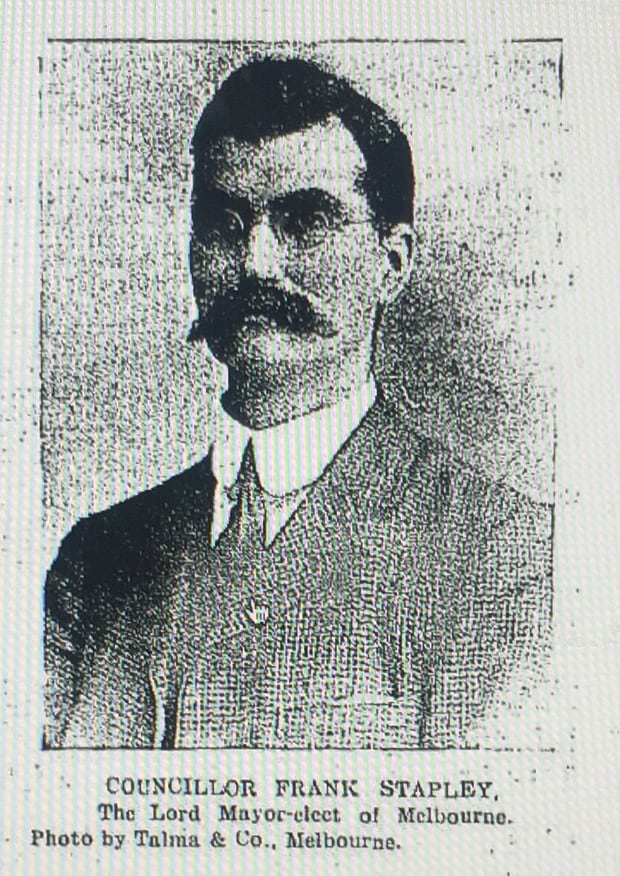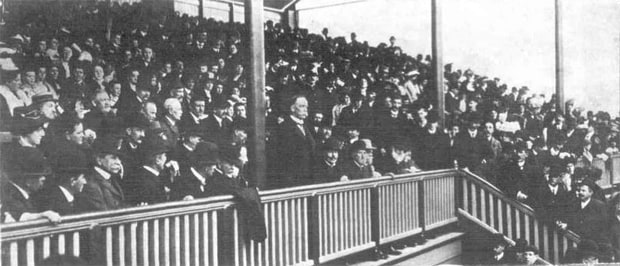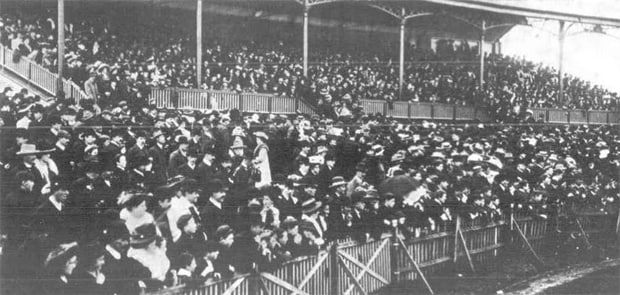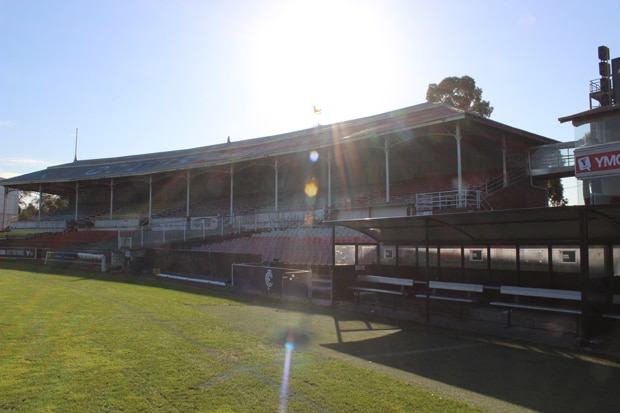Almost 109 years after its formal opening, the Ald. Gardiner Stand, with its graceful edifice in brick, timber and cast iron, continues to cast its imposing shadow over the old Carlton ground.
And yet, few would know the identity of the man responsible for the grand design – a future Melbourne Lord Mayor who contributed meaningfully to this city as an architect and town planner of renown.
Frank Stapley – son of local policeman Isaac Hilton and Mary Ann Hilton - was born in Hove, Sussex, England, on October 24, 1858. A forefather of Frank’s was Anthony Stapley, who in 1649 was one of 55 signatories to the death warrant of King Charles I.
David Dunstan, in an article published in the Australian Dictionary of Biography in 1990, penned the following in respect of Frank Stapley’s life;
Educated at Hove and trained as an architect, Stapley embarked on a sailing ship to South Africa in 1880 where he practised in Cape Town and on the Kimberley diamond fields. After contracting fever, in 1883 he returned to England.
On 5 January 1884 at the parish church, Exeter, he married Eliza Sutherland Dunning (d.1924) with whom he migrated to Victoria. He joined the office of William Salway, a leading Melbourne architect, worked with the city surveyor’s department of the Melbourne City Council in 1887-93, and later practised on his own account and in partnership. Stapley designed domestic, commercial and industrial buildings, including the West Melbourne stadium which had a large interior space without internal roof supports.

One of the earliest references to Stapley in a Carlton Football Club context appears in the following report of the proposed construction of a new grandstand at the ground, in The Argus of January 2, 1909.
Steps are being taken to provide a new grandstand for the Carlton Cricket Ground. The ground committee of the Carlton Cricket Club (which consists of three members of the football and three members of the cricket club, with an independent chairman) have instructed Mr. Frank Stapley, the club's architect, to call for tenders for the erection of a new grand stand on the north side of the enclosure.
Alternate tenders will be called for a building of five bays, to seat 2500 people, and a structure of three bays, to accommodate 1200. If the plan with the five bays is carried out, the stand will extend practically from a point near the press-box to the entrance to the members' reserve. Provision will also be made for dressing, refreshment and club rooms, and a gymnasium in the basement. The necessary flagpoles to bear the colors of the competing teams, and every effort will be made to have the ground completed by April, in order to accommodate the crowds at the football matches.

James Burston, Lord Mayor of Melbourne, opens the Ald. Gardiner Stand, 1909. (Photo: Supplied)
On Saturday, June 19, 1909, prior to the first bounce of the Round 9 match with Essendon, the Ald. Gardiner Stand was formally opened. The then Lord Mayor of Melbourne, James Burston, completed the noble deed as men in their boaters and bowlers watched on.
GHOSTS OF PRINCES PARK TOUR RETURNS FOR 2018
The Lord Mayor told the gathering that he had been a Carlton boy in his youth, that the old club was naturally very near to his heart and that the old Carlton footballers were his heroes – many of them, including George Robertson and Dick Frayne, who were present.
The Argus also reported that the grandstand comfortably seated 1400 people, and the wide passage at back affords standing room for 400 more. It noted that the view of the oval from the stand is well-night perfect, the iron pillars in front offering very little obstruction.
“Up to the present close on £2,500 has been expended on the structure, of which £900 has been provided in cash by the football club, but the interior fittings will be attended to later on,” the report said.
“The plans provide for five bays, of which three have been completed. In a few days the committee hope to announce the completion of a further loan of £2,000 when the remaining two bays will be taken in hand at once.
Mr. Frank Stapley is the architect, and Messrs Spargo and Taylor contractors.”
As the Carlton ground grew in stature so too did the Gardiner Stand in the psyche of those who sought its sanctuary. The Leader’s unnamed reporter who covered the Carlton-Fitzroy match of Round 6, 1914, wrote on May 30 of that year;
Less than a score of years ago the Carlton ground was a tip for garbage, with a swimming hole, sometimes turned into a lethal chamber for dogs in the low corner. Good football gates and judicious management have turned the reserve into a thing of beauty and a joy for ever, with its setting of spacious park lands. The latest improvement is a smart white fence around the arena, to which the ground management, warned by the unseemly melee of a few weeks ago, have affixed notices threatening condign punishment to any barracker, turbulent or otherwise, who wishes to display his antics on the green sward.

Opening of Ald. Gardiner Stand, 1909. (Photo: Supplied)
Scattered around the ring on the inside of the fence one noticed at different spots stalwart men in blue ready and willing to carry out the behests of the authorities.
The capacious grand stand, also, is the best in the suburbs, and its strong, light and graceful design is a credit to Mr. F. Stapley, the club’s architect. The accommodation for the crowd at Carlton is the most spacious in the metropolis, as the stand and the great bank right round the ground can provide a good view for over 50,000 persons.”
The Gardiner Stand was but one of the many and varied achievements realised by Stapley in his long and illustrious career.
Dunstan again picks up on the story;
As Melbourne’s chief advocate of town planning, he (Stapley) was to be influential for more than three decades. The Victorian Town Planning and Parks Association was formed in 1914 and a series of conferences was held throughout Australia in 1917-19. A key figure in this movement, Stapley brought to it the prestige of his presidency of The Royal Victorian Institute of Architects in 1920-21. He was appointed foundation chairman of the nine-member Metropolitan Town Planning Commission in 1922. The commission dealt with many important issues and in its final report (1929) produced a master plan which focused on road transport, land-use zoning and open space. Although well received in professional circles, its recommendations were never comprehensively implemented: with the onset of the Depression, the economic and political climate was unfavourable, and planning at the metropolitan level was inhibited by a plethora of municipalities, much to Stapley’s regret.
A member of Melbourne City Council from 1901, Stapley was mayor in 1917-18 and an alderman in 1921-39. He chaired the council’s parks and gardens committee, and was also a member of the Melbourne and Metropolitan Board of Works, the Health Commission and the National War Memorial Committee. In 1926 he became the subject of society interest when, following the death of his elder brother Harry, he refused to claim a family title of dubious authenticity, observing that ‘it would hardly harmonise with conditions out here’. Tall and handsome, Stapley was a personable reformer. An atypical city councillor of the period, with little in common with his colleagues, he was greatly disappointed by the failure of State and civic authorities to adopt his visionary plan. He was still urging Melburnians in 1935 to prepare for a population of two million within the next fifty years.
Stapley died in Royal Melbourne Hospital on 11 September 1944 and was buried in Brighton cemetery. On 3 September 1924 at St James’s Anglican Church, West Melbourne, he had married Edith Ellen Simms who survived him.
By the time he had retired from civic life in 1939, Frank Stapley had seen the population of Melbourne and suburbs more than double itself. It was said that one of the subjects to which he had given special study and attention during his time was the growth of the town-planning problems of the metropolitan area.

The Gardiner Stand as it appears today. (Photo: Carlton Media)
Clearly, Melbourne was always at the forefront in the mind of the man for whom the Gardiner Stand affords its silent tribute.
In March 1919, and in drawing attention to the need for a suitable and worthy national war memorial, Stapley, the then President of The Royal Victorian Institute of Architects, Stapley, told delegates at the annual meeting;
Melbourne has few Architectural monuments or trophies or artistic design; the lay-out of our city is without civic centres or radial streets that assist to beautify and help to provide artistic and noble vistas. Our main thoroughfares, although broad and noble in many ways, are not designed to live up to any Architectural feature, and they terminate without squares or any attempt to round off the approaches.
If Princes Bridge had been built with suitable-designed Architectural towers, it would have formed an appropriate terminal to the St. Kilda Road, and a noble gateway to the city proper.
In 1936, the area between the Yarra River and Batman Avenue was named Stapley Parade Reserve in honor of the man to whom the Ald. Gardiner Stand still stands in silent tribute. Identical granite drinking fountains were erected at either end of that reserve – each engraved with ‘Stapley Ave’, now known as Birrarung Marr.




